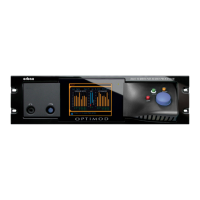2-12
INSTALLATION ORBAN MODEL 8685
• M
ULTIBAND (stereo enhancement, equalization, AGC, and two-band or 5-
Band compression, and loudness control without peak limiting).
• AGC+L
IMIT (stereo enhancement, equalization, AGC, and look-ahead peak
limiting)
• AGC
(stereo enhancement, equalization, and AGC without peak limiting)
If you set
EXT AGC to YES in System Setup, this defeats the AGC. In this
case, choosing:
• MB+L
IMIT results in stereo enhancement, equalization, two-band or 5-Band
compression, and loudness control with look-ahead limiting but without
AGC.
• M
ULTIBAND results in stereo enhancement, equalization, two-band or 5-
Band compression, and loudness control without AGC.
• AGC+LIM
results in stereo enhancement, equalization, and look-ahead lim-
iting.
• AGC causes the input signal to be passed to the analog output with no dy-
namics processing (just stereo enhancement and equalization).
The only reason to use an output without peak limiting is if low delay is
needed, as the 8685’s sophisticated, low-IM peak limiter adds about 12
milliseconds of delay. Note that this is only true if a given output’s D
ELAY
parameter in System Setup is set to M
INIMUM. If DELAY is set to any other
value, the 8685 will automatically add delay to ensure that the in-
put/output delay corresponds to your D
ELAY control setting. In digital
television applications, D
ELAY will usually be set to exactly one frame to
make it easy to retain AV- sync.
In digital radio and netcast applications, you might want to use a low-
delay output to drive your studio monitor speakers as well as talent
headphones.
CAUTION: If an output is configured for no peak limiting, it can clip and
distort. If this happens, correct it by turning down the 8685’s MB
LIMITER
DRIVE control (if you are using MULTIBAND mode) or AGC LIMITER DRIVE
control (if you are using AGC mode). Then save the result as a user pre-
set. Note that these control settings apply only to the active processing
preset. If you use more than one processing preset, you must adjust the
appropriate L
IMITER DRIVE control for each and save each as a user preset.
C) Choose the source to feed the hardware outputs assigned to the 2.0 channel
audio processing (see above for the choices). All four 2.0 processors will be set
identcially.
D) Set the surround output sample rate to 32, 44.1, 48, 88.2, or 96 kHz. 48 kHz is
correct for digital television transmission.
The internal sample rate converter sets the rate at the 8685’s digital out-
put. This adjustment allows you to set the output sample rate to ensure
compatibility with equipment requiring a fixed sample rate. In all cases,
the 8685’s internal processing sample rate is 48 kHz.

